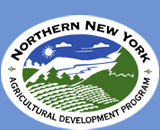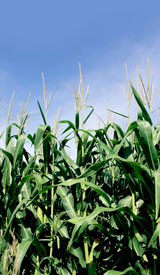November 13, 2009
WH Miner Institute: Catherine Ballard, 518-846-7121x112; Kurt Cotanch
x123
NNYADP Co-Chairs: Joe Giroux: 518-565-4730; Jon Greenwood, 315-386-3231
How Does Later Corn Harvest Impact Cow Health, Milk Production?
Chazy, NY - By farmer request, the Northern New York Agricultural
Development Program has begun research to evaluate the impact of
later-harvested corn on cow digestive health and milk production
efficiency. The high cost of grain (particularly cornmeal in recent
years) along with the weather causing harvest delays has raised concern
for maximizing on-farm production of energy in the form of corn. Some
dairy consultants are recommending farmers delay harvest to capture more
starch in their corn silage crop.
In 2009, the farmers who guide the small grants program of the Northern
New York Agricultural Development Program requested the research that is
being conducted at the W.H. Miner Agricultural Research Institute in
Chazy, NY. They identified the evaluation of the impact of corn maturity
at harvest on nutrient composition, starch and fiber digestibility, and
protein solubility of different corn hybrids as a priority project.
Northern New York Agricultural Development Program Co-Chair and dairyman
Joe Giroux says, “The most critical factor of this research will be in
knowing the impact of the later-ensiled corn silage on the nutritional
quality of the final silage, which ultimately affects cows’ rumen health
and farm profitability.”
W.H. Miner Agricultural Research Institute Director of Research
Catherine S. Ballard and Miner Institute Forage Lab Director Kurt W.
Cotanch are project leaders.
Ballard says, “Some consultants have suggested delaying harvest until
the corn’s whole plant dry matter approaches forty percent. The
reasoning is that corn starch deposition into the kernels is maximized,
and nutrient loss is higher in corn ensiled at lower dry matter
percentages with a resulting loss in milk production value. Whole-plant
corn silage harvested at a higher percentage of dry matter (35-38%DM)
may provide more energy in the form of starch. This, in turn, decreases
the need for purchased grain.”
Whole-plant corn harvesting processes the entire stalk of corn into
silage for feeding to dairy cows. As plants mature, the corn stalk
decreases in digestibility for dairy cows. The amount of time silage
spends in a silo influences protein solubility and starch content. These
changes impact how dairy farmers and nutrition consultants formulate
feed rations.
Cotanch says, “The increase in ruminal starch degradation over time in
the silo could lead to silage rations that have a higher chance of
causing subacute ruminal acidosis.”
In plain terms, subacute ruminal acidosis is an acid stomach in cows.
This condition leads to decreased milk production, efficiency, and
weight loss, which, in turn, results in untimely loss of cows from the
milking herd and economic loss to the farm.
The NNYADP-funded research will also determine if the increase in net
energy in lactation in whole-plant corn silage attained by harvesting
more mature corn may result in more milk per acre.
The Northern New York Agricultural Development Program is a
farmer-driven initiative to ensure the long term economic vitality of
Northern NY’s agricultural production sector and agriculture’s important
contributions to the protection and enhancement of the region’s
environment and rich natural resource base and to communities in New
York State’s six northernmost counties.
Learn more about dairy industry research by contacting your local
Cornell Cooperative Extension or W.H. Miner Agricultural Research
Institute, or on the Northern New York Agricultural Development Program
website at www.nnyagdev.org. # # #
Background:
The Northern New York Agricultural Development Program awards grants for
practical on-farm research, outreach and technical assistance and is
supported by funds from the New York State Legislature through the long
term support of the North Country’s State Senators, and with the support
of NYS Assemblypersons from the region and other areas of the state.
The program receives support (funds, time, land, expertise, etc.) from
Cornell University’s College of Agriculture and Life Sciences, the
Cornell University Agricultural Experiment Station, NYS Agricultural
Experiment Station in Geneva, six Northern New York Cornell Cooperative
Extension Associations, W. H. Miner Agricultural Research Institute,
U.S. Department of Agriculture, New York State Department of Agriculture
and Markets, cooperating farms, agribusinesses across the region, and
others.
The Northern New York Agricultural Development Program is co-chaired by
Joe Giroux and St. Lawrence County dairyman Jon Greenwood. # # #



